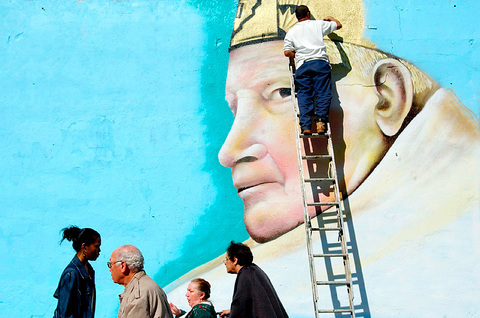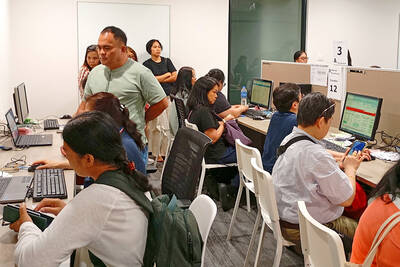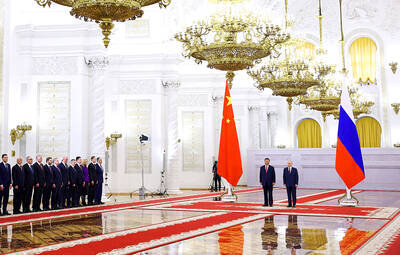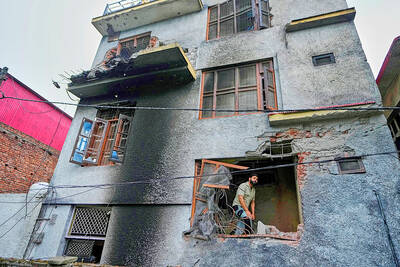Most of the 115 cardinals who will sequester themselves in the Sistine Chapel to find a successor to John Paul II will find themselves in terra incognita in more ways than one.
First of all, all but three of them -- Cardinal Jaime Sin of Manila, who is too ill to attend the conclave beginning April 18, German Cardinal Joseph Ratzinger and William Baum of the US -- have never taken part in a previous election, having been made cardinals by the late Pope.
But more important, their choice will have to reflect a desire both to preserve the heritage of the Roman Catholic Church and to take the necessary initiative to keep it afloat.

PHOTO: EPA
"The future Pope will find it difficult not to continue the work of his predecessor, but it will be even more difficult to continue it," said Cardinal Jose Policarpo, patriarch of Lisbon.
The cardinals will share a concern for preserving the unity of the Church, which has been sorely tested by the widening gap between the countries of ancient Christianity and the Third World.
The same concern motivated John Paul II, who made concessions while trying to contain some of the ripple effects of the reforms of the Second Vatican Council in the 1960s.
Like a shepherd who must surround his flock quickly to keep it together, the late Pope circled the globe several times in a bid to prevent dangerous divergences.
Examples include African priests in open sexual relationships, high divorce and remarriage rates in Europe and North America, and the sometimes violent social militancy of Latin American priests immersed in liberation theology.
These dangers persist, and John Paul II's successor must continue to address them.
The task is made all the more difficult by the fact that the problems of the Church in the developed world seem highly abstract in the Third World.
Faced with a dwindling recruitment base and an aging European clergy, the idea of dropping the celibacy requirement for priests may become thinkable.
This could come about after a transition phase during which married men above a certain age would be ordained. Of course, the most radical reformists speak of ordaining women.
Many want to see more progress in the ecumenical movement, which stagnated under a John Paul II attached to Roman dogma including that of papal infallibility.
In the developing world, where priests are signing up in growing numbers and women are consigned to age-old traditional roles, such radical ideas seem foreign indeed.
Third World dioceses are also resistant to ecumenism in the face of aggressive Protestant sects.
As for celibacy, a rarely expressed concern in poor countries is that priestly salaries could hardly be expected to pay for the upkeep of a family if priests were allowed to marry.
While John Paul II achieved consensus against abortion more or less throughout the Church, the same cannot be said of condoms, especially in Asian and African countries staggering with rapid population growth and the devastating AIDS pandemic.
In addition to ethical and social issues, the cardinals meeting at the Vatican will also have to think about the internal problems of the Catholic Church, beginning with reform of the Curia, or Church hierarchy, and demands for strengthened collegiality.
The winning candidate -- whose choice is meant to be inspired by the Holy Spirit -- will have to seem able to address these problems while at the same time preserving both the unity and the diversity of the universal Church.

A new online voting system aimed at boosting turnout among the Philippines’ millions of overseas workers ahead of Monday’s mid-term elections has been marked by confusion and fears of disenfranchisement. Thousands of overseas Filipino workers have already cast their ballots in the race dominated by a bitter feud between President Ferdinand Marcos Jr and his impeached vice president, Sara Duterte. While official turnout figures are not yet publicly available, data from the Philippine Commission on Elections (COMELEC) showed that at least 134,000 of the 1.22 million registered overseas voters have signed up for the new online system, which opened on April 13. However,

EUROPEAN FUTURE? Albanian Prime Minister Edi Rama says only he could secure EU membership, but challenges remain in dealing with corruption and a brain drain Albanian Prime Minister Edi Rama seeks to win an unprecedented fourth term, pledging to finally take the country into the EU and turn it into a hot tourist destination with some help from the Trump family. The artist-turned-politician has been pitching Albania as a trendy coastal destination, which has helped to drive up tourism arrivals to a record 11 million last year. US President Donald Trump’s son-in-law, Jared Kushner, also joined in the rush, pledging to invest US$1.4 billion to turn a largely deserted island into a luxurious getaway. Rama is expected to win another term after yesterday’s vote. The vote would

ALLIES: Calling Putin his ‘old friend,’ Xi said Beijing stood alongside Russia ‘in the face of the international counter-current of unilateralism and hegemonic bullying’ Chinese President Xi Jinping (習近平) yesterday was in Moscow for a state visit ahead of the Kremlin’s grand Victory Day celebrations, as Ukraine accused Russia’s army of launching air strikes just hours into a supposed truce. More than 20 foreign leaders were in Russia to attend a vast military parade today marking 80 years since the defeat of Nazi Germany in World War II, taking place three years into Russia’s offensive in Ukraine. Putin ordered troops into Ukraine in February 2022 and has marshaled the memory of Soviet victory against Nazi Germany to justify his campaign and rally society behind the offensive,

CONFLICTING REPORTS: Beijing said it was ‘not familiar with the matter’ when asked if Chinese jets were used in the conflict, after Pakistan’s foreign minister said they were The Pakistan Army yesterday said it shot down 25 Indian drones, a day after the worst violence between the nuclear-armed rivals in two decades. Pakistani Prime Minister Shehbaz Sharif vowed to retaliate after India launched deadly missile strikes on Wednesday morning, escalating days of gunfire along their border. At least 45 deaths were reported from both sides following Wednesday’s violence, including children. Pakistan’s military said in a statement yesterday that it had “so far shot down 25 Israeli-made Harop drones” at multiple location across the country. “Last night, India showed another act of aggression by sending drones to multiple locations,” Pakistan military spokesman Ahmed